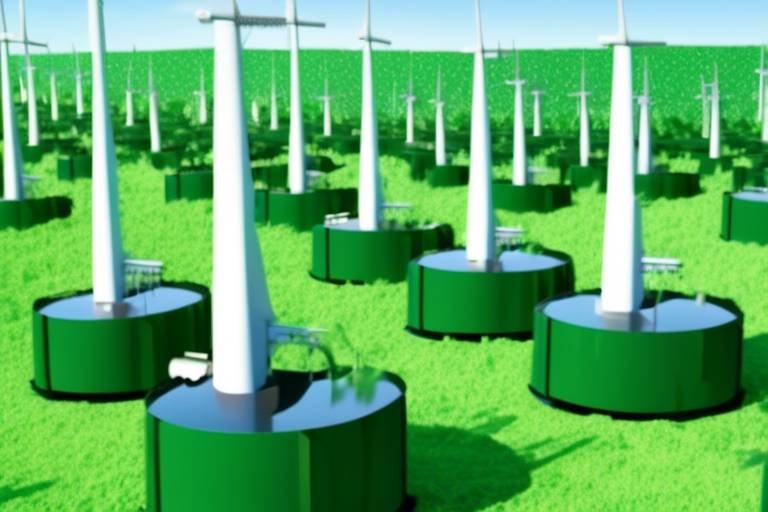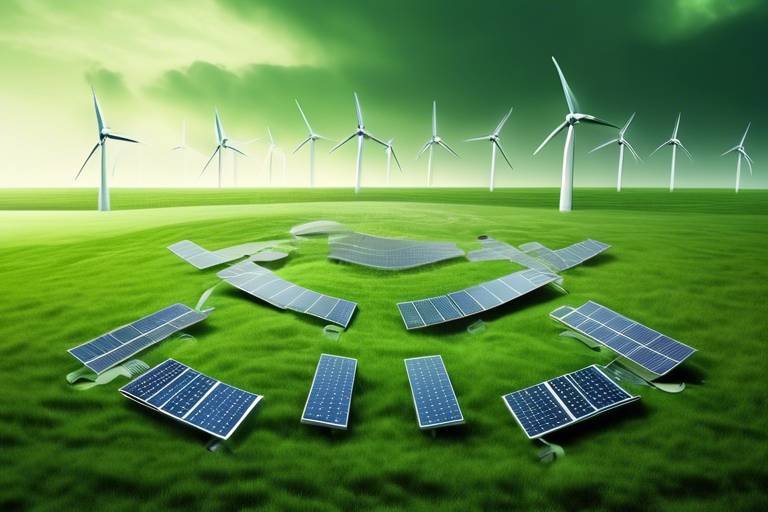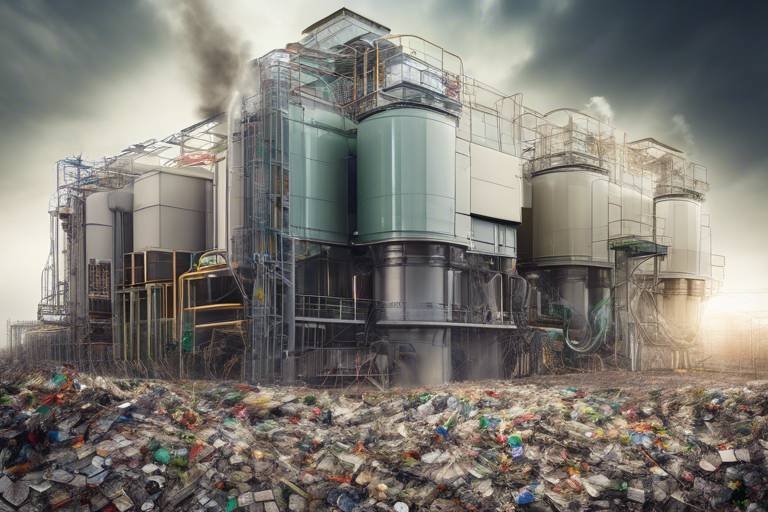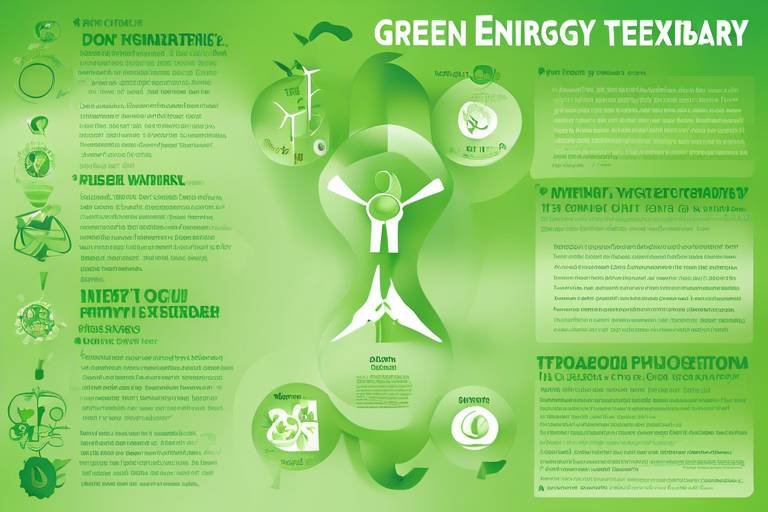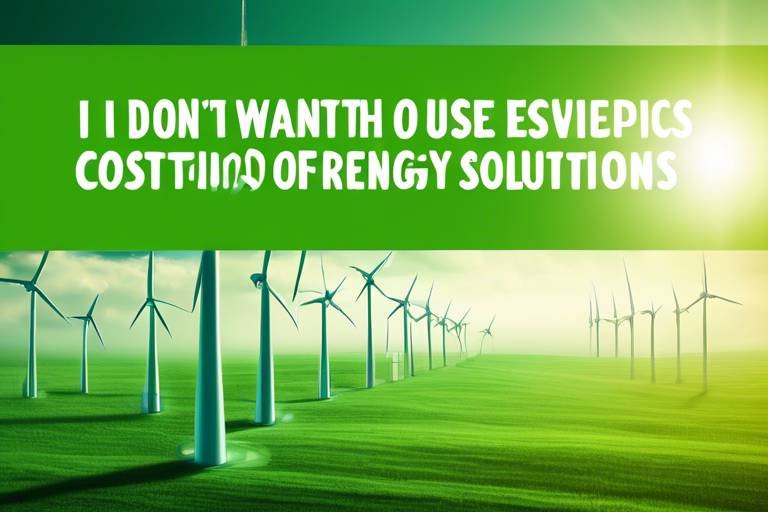An Exploration of Green Energy Technological Innovations
This article delves into the latest advancements in green energy technologies, examining their impact on sustainability, efficiency, and environmental conservation. Discover the innovations shaping the future of energy production and consumption.
In a world increasingly aware of its environmental footprint, renewable energy sources have emerged as the heroes of our time. Imagine harnessing the power of the sun, wind, and water to fuel our homes and industries without depleting the planet's resources. Solar energy, for instance, uses photovoltaic cells to convert sunlight directly into electricity, providing a clean alternative to fossil fuels. Wind energy captures the kinetic energy from wind using turbines, while hydroelectric power generates energy from flowing water. These methods not only help in reducing carbon emissions but also promote sustainability in energy consumption. As we embrace these technologies, we are not just investing in energy; we are investing in a cleaner, greener future.
One of the biggest challenges with renewable energy is its intermittent nature. The sun doesn’t always shine, and the wind doesn’t always blow. This is where advancements in energy storage technologies come into play. By developing efficient storage systems, we can ensure that the energy generated from renewable sources is available when we need it most. From traditional batteries to innovative new systems, the evolution of energy storage is crucial for enhancing grid reliability and managing energy supply effectively.
Battery technology is at the forefront of the energy storage revolution. The latest developments in lithium-ion and solid-state batteries are particularly exciting. Lithium-ion batteries have become the standard for energy storage due to their high energy density and efficiency. However, solid-state batteries promise even greater advancements, offering longer lifespans and faster charging times. These innovations are not just about convenience; they represent a significant leap in our ability to store renewable energy effectively.
As the demand for batteries increases, so does the importance of recycling battery materials. The process of recycling can minimize environmental impacts and promote sustainable practices within the growing battery industry. By reclaiming valuable materials such as lithium, cobalt, and nickel, we can reduce the need for new mining operations, which often have devastating effects on ecosystems. Embracing recycling not only supports sustainability but also helps to create a circular economy where resources are reused rather than discarded.
Looking ahead, emerging battery technologies are set to revolutionize energy storage. Innovations such as lithium-sulfur and flow batteries are on the horizon, promising greater efficiency and longevity. These advancements could lead to batteries that last longer and store more energy, making renewable sources more viable for widespread use. Imagine a world where your home can run entirely on renewable energy, day and night, thanks to these cutting-edge technologies.
Another critical aspect of modern energy solutions is the development of smart grid technologies. These systems enhance the efficiency and reliability of energy distribution, allowing for a seamless integration of renewable energy sources into existing power systems. Smart grids utilize advanced communication and automation technologies to monitor and manage energy flows, ensuring that supply and demand are balanced effectively. This not only helps in reducing energy waste but also enhances the overall resilience of our energy infrastructure.
Beyond energy generation and storage, innovations in energy efficiency are equally vital. Cutting-edge technologies, including smart appliances and building automation systems, contribute significantly to reducing energy consumption and lowering utility costs for consumers. These innovations allow us to use energy more wisely, ensuring that we are not just generating renewable energy but also using it efficiently.
Have you ever wished you could control your home’s energy use with a simple tap on your smartphone? With smart home technologies, this is now a reality. Devices such as smart thermostats, energy-efficient lighting, and energy monitoring systems enable homeowners to optimize their energy consumption in real-time. This means less waste, lower bills, and a more sustainable lifestyle.
In commercial settings, building automation systems play a pivotal role in managing energy use. These systems can control lighting, heating, cooling, and even ventilation based on occupancy and usage patterns. By automating these processes, businesses can achieve significant reductions in energy waste and operational costs, all while contributing to a greener planet.
- What are renewable energy sources? Renewable energy sources are natural resources that can be replenished, such as solar, wind, and hydroelectric power.
- How do energy storage solutions work? Energy storage solutions, like batteries, store excess energy generated from renewable sources for later use, helping to balance supply and demand.
- Why is recycling batteries important? Recycling reduces environmental impact and conserves valuable materials, supporting sustainability in the growing battery industry.
- What are smart grid technologies? Smart grid technologies enhance the efficiency and reliability of energy distribution, integrating renewable sources into existing power systems.

Renewable Energy Sources
In today's world, the **importance of renewable energy sources** cannot be overstated. As we face the pressing challenges of climate change and environmental degradation, the shift towards cleaner energy alternatives is not just a trend; it’s a necessity. Renewable energy sources such as solar, wind, and hydroelectric power have emerged as powerful tools in our quest for sustainability. These energy forms not only help in reducing carbon emissions but also promote a greener, healthier planet for future generations.
To paint a clearer picture, consider the following benefits of renewable energy sources:
- Reduction of Carbon Emissions: Unlike fossil fuels, renewable energy sources produce little to no greenhouse gases during operation, significantly lowering the carbon footprint.
- Job Creation: The renewable energy sector is a booming industry, creating millions of jobs worldwide, from manufacturing to installation and maintenance.
- Energy Independence: By harnessing local renewable resources, countries can reduce their dependence on imported fuels, enhancing energy security.
- Sustainable Development: Renewable energy contributes to sustainable economic growth, providing energy access to underserved communities and improving overall quality of life.
Let’s take a closer look at some of the most prominent renewable energy sources:
| Energy Source | Description | Advantages |
|---|---|---|
| Solar Energy | Energy harnessed from the sun using solar panels. | Abundant, reduces electricity bills, and low maintenance costs. |
| Wind Energy | Energy generated by wind turbines converting wind motion into electricity. | Clean, cost-effective, and can be deployed on land or offshore. |
| Hydroelectric Power | Energy produced by harnessing the flow of water through dams. | Reliable, efficient, and can provide a consistent power supply. |
Each of these energy sources plays a unique role in the broader energy landscape. For instance, solar energy is particularly effective in sunny regions, while wind energy thrives in areas with consistent wind patterns. Hydroelectric power, on the other hand, is often utilized in regions with significant water resources.
Moreover, the integration of these renewable sources into our energy grid not only promotes sustainability but also enhances energy resilience. Imagine a world where your electricity comes from the sun shining on your roof or the wind blowing through your backyard. This isn't just a dream; it's becoming a reality as technology advances and more people embrace renewable energy solutions.
In conclusion, the transition to renewable energy sources is not merely an option; it is an imperative for a sustainable future. By investing in these technologies, we are not only combating climate change but also paving the way for economic growth and energy independence. The journey towards a greener planet is underway, and every step counts!
- What are renewable energy sources? Renewable energy sources are natural resources that can be replenished over time, such as solar, wind, and hydroelectric power.
- How do renewable energy sources reduce carbon emissions? They produce little to no greenhouse gases during operation, which helps mitigate climate change.
- Can renewable energy sources provide enough energy for the entire world? Yes, with advancements in technology and infrastructure, renewable energy can potentially meet global energy demands sustainably.

Energy Storage Solutions
As we dive into the realm of , it's essential to recognize their pivotal role in the renewable energy landscape. With the rise of renewable sources like solar and wind, which are inherently intermittent, we face the challenge of ensuring a steady and reliable energy supply. This is where innovative storage technologies come into play, acting as the backbone of a sustainable energy future.
Imagine a world where the sun shines brightly during the day, generating an abundance of energy, but what happens when night falls? Or when the wind isn't blowing? This is where energy storage systems shine, capturing excess energy produced during peak times and releasing it when demand surges. Battery technologies, in particular, have seen remarkable advancements, making them more efficient and accessible than ever before.
Among the most popular energy storage solutions are batteries, which can be categorized into various types, each with its unique advantages and applications. Let's take a closer look at some of the prominent battery technologies:
| Battery Type | Advantages | Applications |
|---|---|---|
| Lithium-ion | High energy density, lightweight, and long cycle life | Electric vehicles, grid storage, and portable electronics |
| Solid-state | Enhanced safety, higher energy density, and longer lifespan | Future electric vehicles and large-scale energy storage |
| Flow Batteries | Scalable, long-duration storage, and environmentally friendly | Grid storage and renewable energy integration |
These advancements in battery technology not only improve energy efficiency but also enhance the overall reliability of renewable energy systems. But as we embrace these innovations, it's crucial to consider the environmental impact of battery production and disposal. This brings us to the topic of recycling and sustainability.
Recycling battery materials is not just a buzzword; it's a necessity. By reclaiming valuable resources like lithium, cobalt, and nickel, we can significantly reduce the environmental footprint associated with mining and production. Moreover, promoting sustainable practices within the growing battery industry ensures that we are not only meeting today's energy demands but also safeguarding our planet for future generations.
Looking ahead, the future of energy storage is bright with emerging technologies that promise to revolutionize the way we store energy. Innovations such as solid-state batteries and advanced lithium-sulfur batteries are on the horizon, offering longer lifespans, greater efficiency, and enhanced safety. Imagine a battery that could last for decades without losing its capacity—this could be the game-changer we’ve been waiting for!
In conclusion, energy storage solutions are not merely a stopgap; they are a fundamental component of our transition to a sustainable energy future. By investing in advanced technologies and promoting recycling, we can create a resilient energy ecosystem that benefits both consumers and the environment.
- What are energy storage solutions? Energy storage solutions are technologies that capture and store energy for later use, ensuring a reliable power supply when renewable sources are not generating energy.
- Why are batteries important for renewable energy? Batteries help manage the intermittent nature of renewable energy sources, allowing excess energy to be stored and used when demand is high.
- How can battery recycling benefit the environment? Recycling batteries reduces the need for mining new materials, minimizes waste, and lowers the environmental impact associated with battery production.

Battery Technologies
When we think about the future of energy, batteries are often at the forefront of our minds. They are the unsung heroes of the renewable energy revolution, playing a pivotal role in how we store and utilize energy generated from sources like solar and wind. The latest advancements in are nothing short of revolutionary, promising to enhance our energy efficiency and storage capabilities significantly. But what exactly are these advancements, and why do they matter?
One of the most notable developments in recent years is the evolution of lithium-ion batteries. These batteries have become the gold standard for many applications, from electric vehicles to home energy storage systems. Their ability to hold a charge for extended periods while being lightweight makes them ideal for a wide range of uses. However, the quest for better efficiency doesn’t stop there. Enter solid-state batteries, which are emerging as the next big thing in battery technology. Unlike traditional lithium-ion batteries that use liquid electrolytes, solid-state batteries utilize solid electrolytes, which can lead to higher energy densities and improved safety. Imagine a battery that can last longer and charge faster—this is the promise that solid-state technology holds.
But what about the environmental impact? As we dive deeper into the world of battery technologies, we must also consider the sustainability of these advancements. The production of batteries, especially lithium-ion ones, raises concerns about the extraction of raw materials and the energy-intensive processes involved. This is where recycling comes into play. By developing efficient recycling methods, we can minimize waste and reduce the demand for new materials. In fact, many companies are now focusing on creating closed-loop systems where battery materials are continuously reused. This not only conserves resources but also helps in reducing the overall carbon footprint of battery production.
Looking ahead, the future of battery technologies is filled with potential. Researchers are exploring various innovative approaches, such as lithium-sulfur batteries and flow batteries, which could offer even greater efficiencies and longer lifespans. For instance, lithium-sulfur batteries are touted for their ability to hold up to five times more energy than traditional lithium-ion batteries. This could mean that electric vehicles could travel much farther on a single charge, making them more appealing to consumers. Likewise, flow batteries, which store energy in liquid electrolytes, have the advantage of being easily scalable, making them perfect for large-scale energy storage solutions.
In conclusion, battery technologies are not just about powering our gadgets; they are a crucial component of the green energy landscape. As we continue to innovate and improve these technologies, we can expect to see a significant shift in how we produce, store, and consume energy. With advancements in efficiency, sustainability, and performance, the future of battery technology looks bright, paving the way for a cleaner, greener planet.
- What are lithium-ion batteries?
Lithium-ion batteries are rechargeable batteries that are widely used in portable electronics and electric vehicles due to their high energy density and lightweight nature.
- What are solid-state batteries?
Solid-state batteries use solid electrolytes instead of liquid ones, which can lead to higher energy densities and improved safety.
- How can battery recycling help the environment?
Recycling batteries reduces the need for new raw materials, minimizes waste, and decreases the environmental impact associated with battery production.
- What is the future of battery technology?
The future includes advancements like lithium-sulfur and flow batteries, which promise greater efficiency and longer lifespans for energy storage.

Recycling and Sustainability
In today's world, the **importance of recycling** cannot be overstated, especially when it comes to the burgeoning battery industry. As we transition towards greener energy solutions, the demand for batteries—particularly lithium-ion and solid-state batteries—has skyrocketed. This surge in demand raises a critical question: what happens to these batteries once they've reached the end of their life cycle? The answer lies in the **recycling** and **sustainable management** of battery materials.
Recycling batteries is not just an environmental necessity; it's also an economic opportunity. By recovering valuable materials such as cobalt, nickel, and lithium, we can reduce the need for new mining operations, which often have devastating impacts on ecosystems and communities. According to recent studies, recycling can recover up to **95% of the materials** in lithium-ion batteries. This recycling process not only conserves natural resources but also significantly reduces carbon emissions associated with mining and production.
Moreover, the recycling process contributes to sustainability in several ways:
- Resource Conservation: By recycling, we lessen the depletion of finite resources, ensuring that future generations have access to these essential materials.
- Energy Efficiency: Recycling often requires less energy than producing new materials, leading to lower overall energy consumption.
- Waste Reduction: Proper recycling reduces the volume of hazardous waste that ends up in landfills, mitigating environmental pollution.
However, the journey towards a sustainable battery industry is not without its challenges. The current recycling infrastructure is still in its infancy, and many consumers remain unaware of how to properly dispose of batteries. This lack of awareness can lead to improper disposal, which poses serious environmental risks. To combat this, educational initiatives and accessible recycling programs are essential. Communities can implement battery collection points and partner with recycling companies to ensure that batteries are processed correctly.
Looking ahead, innovation in recycling technologies is also on the rise. New methods are being developed to improve the efficiency of material recovery and reduce the environmental footprint of recycling processes. For instance, researchers are exploring hydrometallurgical methods that use less harmful chemicals, making the recycling process safer for both workers and the environment.
In conclusion, the relationship between recycling and sustainability in the battery industry is a pivotal one. As we continue to embrace green energy technologies, it's imperative that we prioritize recycling initiatives to ensure a sustainable future. By doing so, we not only protect our planet but also pave the way for a circular economy where materials are reused and recycled, minimizing waste and maximizing resource efficiency.
- What types of batteries can be recycled? Most rechargeable batteries, including lithium-ion, nickel-cadmium, and lead-acid batteries, can be recycled. Always check local regulations for specific guidelines.
- How can I recycle my old batteries? Look for local collection points or recycling programs in your area. Many retailers also offer battery recycling services.
- What happens to batteries during the recycling process? Batteries are disassembled, and valuable materials are extracted for reuse, while hazardous components are safely disposed of.
- Why is battery recycling important? It conserves natural resources, reduces environmental pollution, and helps create a more sustainable energy future.

Future Innovations
The future of energy storage is not just bright; it's absolutely electrifying! As we dive deeper into the realm of renewable energy, innovative battery technologies are emerging that promise to change the game entirely. Imagine a world where your electric vehicle can charge in minutes instead of hours, or where your home battery can last for days without a recharge. This isn't just a dream—it's becoming a reality thanks to advancements in battery technology.
One of the most exciting developments on the horizon is the rise of solid-state batteries. Unlike traditional lithium-ion batteries that use liquid electrolytes, solid-state batteries utilize solid materials. This change not only enhances safety by reducing the risk of leaks and fires but also significantly boosts energy density. In simple terms, you get more power in a smaller, lighter package. This could revolutionize electric vehicles, making them more efficient and extending their range, which is a crucial factor for many potential buyers.
Another promising innovation is the development of lithium-sulfur batteries. These batteries have the potential to offer up to five times the energy capacity of conventional lithium-ion batteries. Imagine a smartphone that lasts for days on a single charge or a laptop that can run for a week without needing to plug in! The implications for renewable energy storage are enormous, allowing us to store more energy from solar and wind sources, making these technologies more viable and efficient.
Moreover, the integration of artificial intelligence (AI) into battery management systems is set to enhance performance further. AI can optimize charging cycles and predict energy needs based on usage patterns. This means that your battery could learn your habits and adjust its performance accordingly, ensuring you always have power when you need it most.
However, with all these advancements, we must also consider the environmental impact. The battery industry is under scrutiny for its resource extraction processes and waste management. This is where recycling innovations come into play. New methods for recycling battery materials are being developed, focusing on reclaiming valuable elements like lithium, cobalt, and nickel. By closing the loop, we not only reduce the need for new raw materials but also minimize the environmental footprint of battery production.
As we look to the future, it’s clear that the path forward is filled with promise. The advancements in battery technology are not just about improving efficiency; they are about creating a sustainable energy ecosystem. With innovations that enhance energy storage, improve safety, and reduce environmental impact, we are on the brink of a new era in energy consumption. Exciting times are ahead, and the innovations we see today will lay the groundwork for a greener, more sustainable tomorrow.
- What are solid-state batteries? Solid-state batteries use solid electrolytes instead of liquid ones, improving safety and energy density.
- How do lithium-sulfur batteries differ from lithium-ion? Lithium-sulfur batteries can potentially offer five times the energy capacity of lithium-ion batteries.
- What role does AI play in battery management? AI optimizes charging cycles and predicts energy needs based on user patterns, enhancing battery performance.
- Why is battery recycling important? Recycling reduces the need for new raw materials and minimizes the environmental impact of battery production.

Smart Grid Technologies
Smart grid technologies represent a significant leap forward in how we manage and distribute energy. Imagine a power grid that not only delivers electricity but also communicates in real-time with both consumers and energy producers. This revolutionary approach enhances efficiency, reliability, and sustainability in energy usage. By integrating advanced communication technologies, smart grids can optimize energy distribution based on demand, which is crucial as we transition to renewable energy sources.
One of the standout features of smart grids is their ability to facilitate the integration of various renewable energy sources such as solar and wind. Traditional grids often struggle to accommodate the fluctuating nature of these energy sources. However, with smart grid technologies, energy from renewables can be managed more effectively, ensuring that excess energy is stored or redirected where it’s needed most. This not only maximizes the use of clean energy but also minimizes waste, contributing to a more sustainable energy ecosystem.
Moreover, smart grids empower consumers with greater control over their energy consumption. With the help of smart meters, households can monitor their energy use in real-time, identifying patterns and making informed decisions to reduce waste. This level of transparency can lead to significant cost savings on utility bills. For instance, consumers can shift their energy use to off-peak hours when electricity rates are lower, thus optimizing their overall energy expenditure.
To illustrate the benefits of smart grid technologies, consider the following table that outlines key components and their advantages:
| Component | Advantages |
|---|---|
| Smart Meters | Real-time monitoring of energy consumption, leading to better energy management. |
| Demand Response Systems | Adjusts energy consumption based on supply conditions, reducing peak demand and costs. |
| Distributed Energy Resources (DER) | Enhances integration of renewable energy sources, improving grid reliability. |
| Advanced Sensors | Provides real-time data on grid performance, enabling proactive maintenance and management. |
As we look to the future, smart grid technologies will play a pivotal role in shaping a more sustainable energy landscape. The integration of artificial intelligence and machine learning into these systems promises to enhance predictive capabilities, allowing for even more efficient energy distribution. It’s not just about managing energy; it’s about creating a responsive ecosystem that adapts to the changing needs of consumers and the environment.
In conclusion, the evolution of smart grid technologies is not just a trend; it’s a necessity in our quest for a sustainable future. As these technologies continue to develop, they will undoubtedly lead to a more efficient, reliable, and environmentally friendly energy system that benefits everyone.
- What is a smart grid? A smart grid is an electricity supply network that uses digital technology to monitor and manage the transport of electricity from all generation sources to meet the varying electricity demands of end users.
- How do smart grids benefit consumers? Smart grids provide consumers with real-time data on their energy consumption, which helps them manage usage more effectively and save on energy costs.
- Can smart grids integrate renewable energy? Yes, smart grids are designed to integrate renewable energy sources efficiently, managing their intermittent nature and enhancing overall grid reliability.
- What role do smart meters play in smart grids? Smart meters allow consumers to track their energy usage in real-time, enabling better energy management and cost savings.

Energy Efficiency Innovations
In today's fast-paced world, energy efficiency has become more than just a buzzword; it's a necessity. As we grapple with the effects of climate change and the ever-increasing demand for energy, innovations in energy efficiency are paving the way for a sustainable future. These advancements not only help in reducing energy consumption but also lead to significant cost savings for consumers. Imagine being able to cut down your utility bills while contributing to a healthier planet! Sounds appealing, right? Well, that's exactly what these innovations aim to achieve.
One of the most exciting areas of development is in smart appliances. These aren't your average kitchen gadgets; they are designed with cutting-edge technology that allows them to optimize energy use based on your habits. For instance, a smart refrigerator can adjust its cooling settings according to the contents inside and the time of day, ensuring that energy is used efficiently without sacrificing food preservation. Moreover, smart appliances can be controlled remotely through mobile apps, enabling you to monitor and adjust their settings even when you're not home. This level of control not only enhances convenience but also empowers consumers to make informed decisions about their energy use.
Another significant innovation is the emergence of building automation systems. These systems integrate various technologies to manage energy consumption in commercial buildings effectively. Imagine a skyscraper that can adjust its lighting, heating, and cooling systems based on occupancy levels and outside weather conditions. This is not just a dream; it's a reality in many modern buildings today. By utilizing sensors and advanced algorithms, building automation systems can lead to substantial reductions in energy waste and operational costs. They help ensure that energy is used only when and where it's needed, making buildings smarter and more sustainable.
To give you a clearer picture, take a look at the following table that outlines the impact of these innovations:
| Innovation | Benefits | Impact on Energy Consumption |
|---|---|---|
| Smart Appliances | Remote control, optimized energy use | Up to 30% reduction in energy use |
| Building Automation Systems | Real-time monitoring, reduced operational costs | Up to 40% reduction in energy waste |
Moreover, the integration of renewable energy sources with these energy-efficient technologies creates a powerful synergy. For instance, a solar-powered home equipped with smart appliances can drastically reduce its reliance on the grid. This not only lowers electricity bills but also minimizes carbon footprints. It's like having your cake and eating it too — you get to enjoy the benefits of modern living while being an eco-warrior!
As we look to the future, the potential for energy efficiency innovations is boundless. With advancements in artificial intelligence and machine learning, we can expect even smarter systems that learn from our behaviors and adapt accordingly. Imagine a home that knows when you're about to leave for work and adjusts the thermostat or turns off unnecessary lights automatically. This level of personalization will not only enhance comfort but also drive energy savings to new heights.
In conclusion, energy efficiency innovations are not just about saving money; they represent a fundamental shift in how we approach energy consumption. By embracing these technologies, we can create a more sustainable future for ourselves and generations to come. So, are you ready to jump on the energy efficiency bandwagon? Your wallet and the planet will thank you!
- What are smart appliances? Smart appliances are devices that use advanced technology to optimize energy use and can be controlled remotely.
- How do building automation systems work? They integrate various technologies to manage energy consumption based on real-time data.
- Can energy efficiency technologies really save money? Yes, they can significantly reduce utility bills by minimizing energy waste.
- What is the future of energy efficiency innovations? The future looks promising with advancements in AI and machine learning leading to even smarter energy management systems.

Smart Home Technologies
In today's fast-paced world, have emerged as a game-changer in the quest for energy efficiency. Imagine walking into your home and having it adjust the lighting, temperature, and even the appliances based on your preferences—all without lifting a finger! This seamless integration of technology not only enhances convenience but also plays a significant role in reducing energy consumption. But how exactly do these smart devices work, and what benefits do they bring to the table?
At the heart of smart home technologies are devices that communicate with each other and with you, creating an ecosystem that optimizes energy use. For instance, smart thermostats can learn your schedule and adjust heating or cooling accordingly, ensuring that energy isn't wasted when you're not at home. Similarly, smart lighting systems can automatically turn off lights in unoccupied rooms, contributing to significant energy savings over time.
But the benefits go beyond just energy savings. These technologies can also lead to lower utility bills and a reduced carbon footprint. By using smart appliances that operate during off-peak hours, homeowners can take advantage of lower energy rates, making it a win-win situation. Moreover, many smart devices offer real-time energy monitoring, allowing users to track their consumption patterns and make informed decisions about their energy use.
Here's a quick look at some popular smart home technologies and their impact on energy efficiency:
| Device | Function | Energy Savings |
|---|---|---|
| Smart Thermostat | Adjusts heating/cooling based on occupancy | Up to 30% on heating bills |
| Smart Lighting | Automatically turns off/on based on occupancy | Up to 20% reduction in lighting costs |
| Smart Appliances | Operates during off-peak hours | 15-25% savings on energy bills |
As we embrace these innovations, it’s essential to consider the interconnectivity of these devices. Many smart home systems can be integrated with voice-activated assistants, allowing you to control your home environment with simple voice commands. Imagine saying, "Hey Google, turn off all the lights," and watching as your home responds instantly. This level of control not only enhances convenience but also encourages users to be more mindful of their energy consumption.
However, it's important to note that while smart home technologies offer numerous benefits, they also require a reliable internet connection and may involve initial setup costs. But when you weigh these factors against the long-term savings and environmental benefits, the investment often pays off. Plus, many utility companies now offer incentives or rebates for homeowners who invest in energy-efficient technologies, making it easier to jump on the smart home bandwagon.
In conclusion, smart home technologies are not just a trend; they represent a fundamental shift in how we interact with our living spaces. By embracing these innovations, we can create a more sustainable future, one home at a time. Are you ready to transform your home into a smart, energy-efficient haven?
- What are smart home technologies? Smart home technologies refer to devices and systems that automate and optimize home functions, such as lighting, heating, and appliances, to improve energy efficiency and convenience.
- How do smart thermostats save energy? Smart thermostats learn your schedule and adjust heating and cooling based on your presence, ensuring energy is not wasted when you're away.
- Are smart home devices expensive? While there may be an initial investment, many smart devices lead to significant long-term savings on energy bills, and some utility companies offer rebates.
- Can I control smart home devices remotely? Yes, most smart home devices can be controlled via smartphone apps, allowing you to manage your home’s energy use from anywhere.

Building Automation Systems
Building Automation Systems (BAS) are transforming the way we manage energy consumption in commercial and residential buildings. Imagine a world where your building knows when to heat, cool, or light itself—this is not just a dream; it's a reality made possible by advanced automation technologies. BAS integrate various systems, such as heating, ventilation, air conditioning (HVAC), lighting, and security, into a single cohesive platform. This integration allows for real-time monitoring and control, significantly enhancing energy efficiency.
One of the most significant advantages of BAS is their ability to optimize energy use based on occupancy and environmental conditions. For instance, if a room is unoccupied, the system can automatically adjust the temperature and lighting to conserve energy. This level of automation not only reduces waste but also lowers operational costs for businesses. In fact, studies have shown that implementing a BAS can lead to energy savings of 15% to 30%, depending on the building's size and usage patterns.
Furthermore, BAS contribute to sustainability by facilitating the use of renewable energy sources. For example, when solar panels are installed, a BAS can manage the energy produced by these panels, ensuring that it is used efficiently throughout the building. By prioritizing renewable energy, buildings can significantly reduce their carbon footprint and contribute to a healthier planet.
In addition to energy savings, BAS enhance occupant comfort and productivity. With the ability to adjust lighting and temperature based on individual preferences, occupants can enjoy a more tailored environment. This personalization can lead to increased satisfaction and productivity, as people are more likely to thrive in spaces that cater to their needs.
However, implementing a BAS is not without its challenges. The initial investment can be substantial, and the complexity of integrating various systems requires skilled professionals. Yet, the long-term benefits often outweigh these initial hurdles. As technology continues to evolve, the cost of automation systems is expected to decrease, making them more accessible to a broader range of buildings.
To further illustrate the impact of Building Automation Systems, consider the following table showcasing the key components and their benefits:
| Component | Benefits |
|---|---|
| HVAC Control | Optimizes heating and cooling based on occupancy, reducing energy costs. |
| Lighting Control | Adjusts lighting based on natural light availability and occupancy, enhancing comfort and saving energy. |
| Security Systems | Integrates with other systems to provide comprehensive security while optimizing energy use. |
| Energy Monitoring | Tracks energy consumption in real-time, identifying areas for improvement and cost savings. |
In conclusion, Building Automation Systems are a pivotal innovation in the quest for energy efficiency and sustainability. They not only reduce operational costs but also enhance the quality of life for occupants. As we move toward a greener future, the adoption of BAS will be crucial in shaping energy-efficient buildings that meet the needs of both businesses and the environment.
- What is a Building Automation System? A BAS is a centralized control system that manages a building's heating, cooling, lighting, and other systems to optimize energy use and enhance comfort.
- How much can a BAS save on energy costs? Implementing a BAS can lead to energy savings of 15% to 30%, depending on the building's characteristics and usage.
- Is it expensive to install a Building Automation System? While the initial investment can be significant, the long-term savings and benefits often justify the cost.
- Can a BAS integrate with renewable energy sources? Yes, BAS can manage and optimize the use of renewable energy, such as solar power, within a building.
Frequently Asked Questions
- What are the main types of renewable energy sources?
The primary renewable energy sources include solar, wind, and hydroelectric power. Each of these sources plays a crucial role in reducing carbon emissions and promoting sustainability. Solar energy harnesses sunlight, wind energy captures the power of the wind, and hydroelectric power utilizes flowing water to generate electricity. Together, they form the backbone of a greener energy future.
- How do energy storage solutions work?
Energy storage solutions, such as batteries and other systems, are essential for managing the intermittent nature of renewable energy sources. They store excess energy generated during peak production times and release it when demand is high. This capability enhances grid reliability and ensures that renewable energy can be used efficiently, even when the sun isn't shining or the wind isn't blowing.
- What advancements have been made in battery technologies?
Recent advancements in battery technologies, particularly lithium-ion and solid-state batteries, have significantly improved energy efficiency and storage capabilities. These innovations promise longer lifespans, faster charging times, and greater energy density, making them ideal for both consumer electronics and renewable energy systems.
- Why is recycling battery materials important?
Recycling battery materials is crucial to minimizing environmental impact and promoting sustainability. By recovering valuable materials like lithium and cobalt, we can reduce the need for new mining operations, which often harm ecosystems. Plus, recycling helps to create a circular economy within the growing battery industry, ensuring that resources are used efficiently.
- What are smart grid technologies?
Smart grid technologies enhance the efficiency and reliability of energy distribution. They facilitate the integration of renewable energy sources into existing power systems by using advanced communication and automation technologies. This means that energy can be distributed more effectively, reducing waste and improving overall grid performance.
- How do smart home technologies contribute to energy efficiency?
Smart home technologies allow homeowners to monitor and control their energy consumption in real-time. Devices such as smart thermostats and energy-efficient appliances can adjust usage based on patterns and preferences, leading to significant reductions in energy waste and lower utility bills. It’s like having a personal energy manager right in your home!
- What are building automation systems and their benefits?
Building automation systems manage energy use in commercial buildings by controlling lighting, heating, and cooling systems. These systems optimize energy consumption, leading to substantial reductions in energy waste and operational costs. Think of it as having a smart assistant that ensures your building runs efficiently while saving money!


